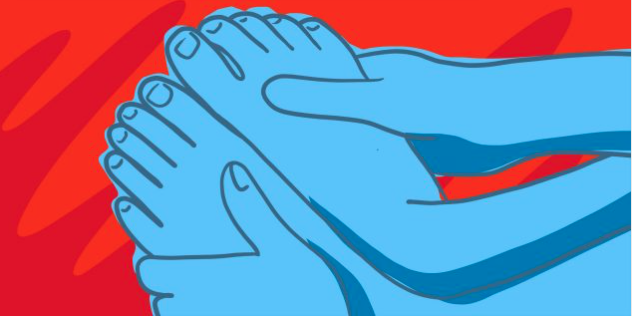Why feet and hands are cold and what to do about it

Let’s start with the basics. Most often, icy limbs are normal. Feet and hands are always the first to get cold and the last to get warm. It is a necessary element of the survival mechanism.
When we enter a cold environment, the brain causes the blood vessels in the limbs to constrict. Thus, blood circulation in the periphery is limited, the blood cools less and helps to retain heat in more important internal organs than the feet or palms.
However, sometimes it happens like this: it seems to be not too cold around, but the hands and feet are still icy and refuse to warm up. Here’s what it could be related to .
1. You are worried, you are stressed.
The natural response of the body to a stressful situation is the release of adrenaline into the blood. This hormone helps mobilize and effectively prepares us for a fight-or-flight situation. One of the key moments of preparation is a sharp narrowing of blood vessels in the periphery. Spasm is necessary in case you injure your arm or leg during a fight or flight: there will be less blood loss, which means it will not endanger your life.
Of course, in the modern world, stress is rarely associated with an attack by a toothy predator or an enemy armed with a sharp sword. But the reactions of the body remain the same: the vessels in the extremities narrow sharply, blood circulation deteriorates. The result is a decrease in temperature in the hands and feet.
What to do
The most important thing is to relax and calm down. As soon as you get rid of stress, your legs and arms will become warm again.
2. You have circulation problems
Poor blood flow is one of the most common reasons limbs become icy. Poor circulation can be caused by a variety of factors:
- an uncomfortable position, being in which compresses the blood vessels;
- varicose veins;
- high cholesterol , which creates plaques that narrow the lumen of blood vessels;
- smoking;
- cardiovascular disorders;
- sedentary lifestyle.
What to do
If the problem of icy feet haunts you regularly, consult a therapist. He will help to find out what exactly caused the circulatory disorders, and will give the necessary recommendations for prevention. If we are talking about a one-time situation, most likely, it will be enough to get up and stretch.
3. You have iron deficiency anemia
Simply put, a lack of hemoglobin in the blood. Perpetually cold hands and feet are one of the clearest symptoms of this condition.
What to do
Lack of iron, as a rule, makes itself felt by weakness, fatigue, brittle hair and nails. If, along with icy limbs, you observe these signs in yourself, consult a therapist. The doctor will offer you to do a blood test, and according to its results, he will advise you to adjust the diet or prescribe special drugs.
4. You don’t have enough thyroid hormones
Hypothyroidism is a fairly common condition, which in the initial stages almost does not make itself felt. Well, except for little things: fatigue, a tendency to edema, weight gain, constipation, dry skin … Cold hands and feet are also one of the early symptoms of a lack of hormones important for metabolism.
What to do
Again, go to the doctor (you can immediately go to the endocrinologist) and do a blood test for thyroid hormones. According to its results, if necessary, the doctor will prescribe you additional examinations and treatment.
5. You have diabetes
Elevated blood glucose levels have a bad effect on blood vessels: they lose elasticity and narrow. Because of this, blood flow to the tissues worsens and the limbs begin to freeze.
In addition, diabetes has an unpleasant complication – peripheral neuropathy, when nerve endings in the feet are damaged due to constantly high sugar levels. As a result, you may feel as if your feet are on fire or, on the contrary, icy.
What to do
Consult a therapist to confirm or refute possible diabetes. If the disease is diagnosed, the doctor will offer you a treatment that will help get rid of coldness in the legs.
6. You have kidney problems
Failures in the work of the kidneys lead to the occurrence of edema, in which the vessels are compressed and, again, blood circulation is disturbed. The extremities are the first to suffer from swelling and, as a result, a constant feeling of cold.
What to do
Contact your therapist again. He will prescribe you tests that will help check the performance of the kidneys. And if necessary, he will prescribe drugs that will help get rid of the swelling and the unpleasant symptoms associated with it.
7. You have anorexia
This eating disorder leads to the fact that a person refuses to eat and rapidly loses weight. Due to the lack of adipose tissue caused by anorexia, it becomes difficult for the body to retain heat. In order to maintain the temperature necessary for the functioning of vital internal organs, the brain restricts blood circulation in the periphery – in the limbs.
What to do
Anorexia has enough symptoms besides cold feet and hands. The key ones are sudden weight loss and fear of “extra” calories. If this is about you, be sure to visit a therapist so as not to miss the development of serious disorders.
8. You chronically do not get enough sleep.
Lack of sleep slows down metabolism in general and blood circulation in particular. And the violation of the latter, among other things, leaves us with icy feet.
What to do
Give yourself the opportunity to sleep and in the future try to sleep at least 7-8 hours a day. This will help not only warm the limbs, but also have a beneficial effect on well-being and health in general.